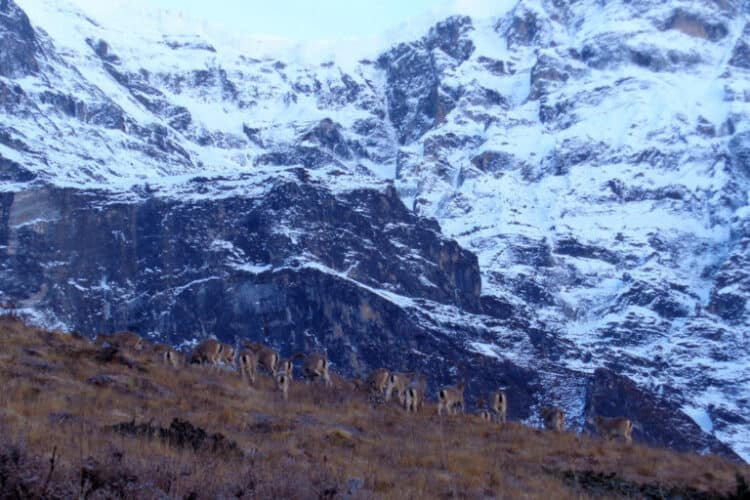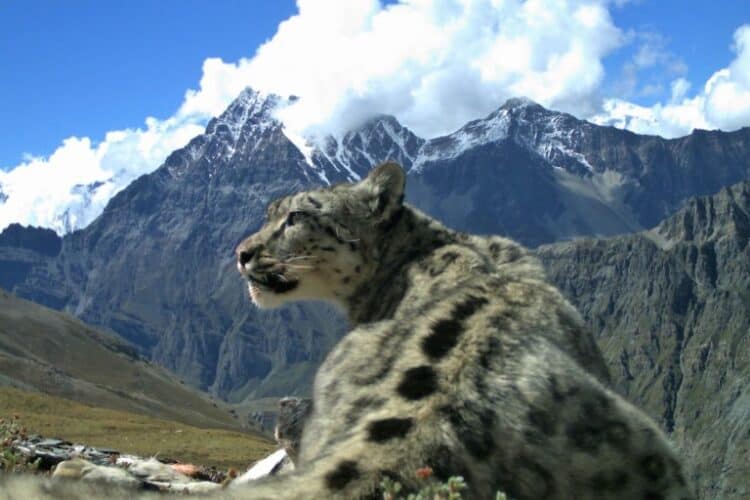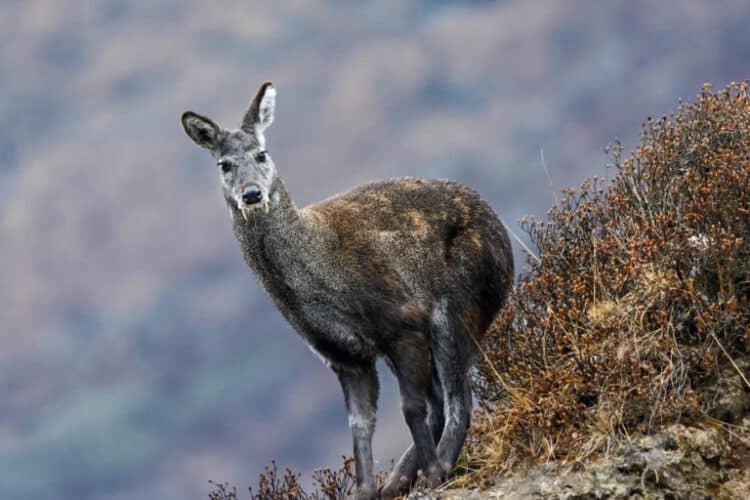KATHMANDU — A tiger sits quietly surrounded by trees, observing something in the distance. It then roars and darts toward its target: a leopard that jumps down from a tree. The two big cats confront one another, but with the leopard taking the submissive stance of lying on the ground, the standoff doesn’t escalate into a catfight, and both back off.
That was the scene captured in an undated viral video believed to be from a forest in India. This led at least one social media user in neighboring Nepal to ask: As tigers, leopards and snow leopards bear the brunt of climate change, is it possible that their habitats will overlap in the future, pushing them into direct competition for prey and habitat?
There’s no easy answer, conservationists say. “We don’t have enough research to answer the question clearly,” says conservationist Bikram Shrestha. “But we have seen that whenever the habitats of big cats overlap, they tend to avoid each other, and the stronger one displaces the weaker one.”
Conservationists have traditionally considered ‘endangered’ tigers (Panthera tigris) the apex predators of Nepal’s southern plains; ‘vulnerable’ leopards (Panthera pardus) as reigning in the country’s hill region; and ‘vulnerable’ snow leopards (Panthera uncia) lording it further north in the mountains.
This, at least, is the way it’s taught in the country’s schools. But various studies have shown that climate change is increasingly pushing tigers and leopards further north in search of suitable habitat, encroaching on the territory of snow leopards.
There’s already an overlap in the range of the three species, especially at higher elevations. Camera traps have recorded tigers at an elevation of more than 3,000 meters (9,800 feet) in eastern Nepal — well inside snow leopard land.
In neighboring India and Bhutan, they’ve been photographed even higher: at roughly 3,600 and 4,000 m (11,800 and 13,100 ft) respectively. Leopards, meanwhile, have been photographed at altitudes as high as 5,400 m (17,700 ft). Snow leopards are believed to live at an altitude of 3,000-5,000 m (9,800-16,400 ft).

In a head-to-head between the two lower-altitude cats, tigers have been known to displace leopards to the fringes of their habitat. “Common leopards have a similar prey base compared to tigers,” conservationist Maheshwar Dhakal told Mongabay. “They also face habitat losses and other anthropogenic pressures and are being forced to the margins of protected areas, where they become more likely to get into conflicts with local people.”
Little is known about how tigers interact with snow leopards, Shrestha says, given that there’s not as much overlap between their ranges. “However, we can say that as the snow leopard is weaker than the tiger, [the tiger] is likely to displace snow leopards if they do share a common habitat,” he says. He adds it would be the same scenario for leopards and snow leopards: The odds are stacked in favor of leopards because they’re a more generalist species, Shrestha says.
Kedar Baral, a conservationist who has studied the potential impact of climate change on the habitat and distribution of leopards, says interactions between them and snow leopards could become more common in a warmer world. “Our study shows that the common leopards could be moving north as previously unsuitable habitats at higher altitudes become suitable due to warming.”
Shrestha’s research shows that snow leopards are also moving uphill as their current range warms up. But with limited room to move into, their habitat will effectively shrink, even as they compete with leopards for this scant space.
Researchers studying tigers say there’s no evidence yet suggesting that tigers may prefer living at higher altitudes. Kanchan Thapa, a conservation biologist at WWF, says he believes this is an unlikely scenario. “I believe that most of the tigers we have found in high altitudes are transient tigers that are exploring the habitat after separating from their mothers,” he says. “The grasslands in the south are going to be the home for the core population.”
Whatever the interaction between the cats may look like in the future, it’s likely to be influenced by another actor: humans. “The other interesting bit is that human settlements are also moving north,” Shrestha says. “Due to climate change, lower altitudes are getting hotter and higher altitudes are becoming suitable for human settlement.”
And history has shown that, in confrontations between big cats and humans, the latter always prevail.
This article by Abhaya Raj Joshi was first published by Mongabay.com on 28 February 2023. Lead Image: A snow leopard in the Himalayan landscape. Image by USAID Biodiversity & Forestry via Flickr (CC BY-NC 2.0).
What you can do
Support ‘Fighting for Wildlife’ by donating as little as $1 – It only takes a minute. Thank you.
Fighting for Wildlife supports approved wildlife conservation organizations, which spend at least 80 percent of the money they raise on actual fieldwork, rather than administration and fundraising. When making a donation you can designate for which type of initiative it should be used – wildlife, oceans, forests or climate.







Leave a Reply